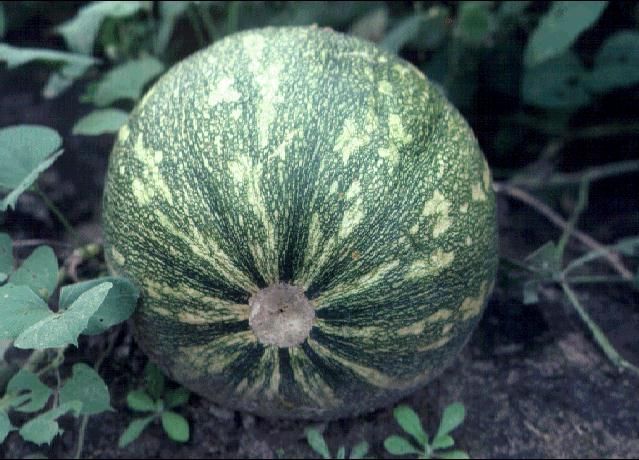Calabaza—Cucurbita moschata Duch. ex Lam.1
Calabaza is the common name of several of the many strains of pumpkins and squashes grown in the tropics. In Florida, calabaza refers to the Cuban pumpkin, also called Cuban squash. Other common names reported are auyama, ayote, and zapallo. In 1991, calabaza production in South Florida stood at about 2500 acres valued at over $5 million.

Credit: James M. Stephens
Description
Calabaza grows on a very long vining plant similar to other winter-type squashes. The leaves are mottled and grayish green in color. The fruits vary in size, shape, and color owing to outcrossing and strain selection. Some weigh up to 50 pounds. The most common form of fruit weighs about 5–12 pounds and is round and flattened a bit on the top and bottom. Its colors are mottled green or yellow and buff-cream. Fruits with elongated necks are also seen quite often in the Dade County area. The light yellow-colored interior is firm and meaty, with a fairly large central cavity. Like all moschatas, the seeds are rather small for squash. The dried matted pulpy fibers at the seed edges give the seeds a somewhat ragged appearance.
Culture
Calabaza tolerates hot weather conditions as well as other members of the cucurbit family. It is a tender crop easily injured by frost and freezes. It should be planted early in the spring as soon as the danger of frost is past. In frost-free areas of the state, calabaza may be planted from August through March. Even in central Florida, fall production is possible in most years.
Seeds of calabaza are seldom found in seed company catalogs. Gardeners should try to obtain a calabaza in a South Florida market and then save the seeds. Considerable variation in plant characteristics from these seeds should be expected. Two Florida-developed varieties are 'La Primera' and 'La Segunda'.
Since plants tend to be excessively vining, the rows should be spaced 6–9 feet apart, and the plants spaced 4 feet apart, in the row.
Cultural practices are similar to those for the common kinds of squashes. Because of wide plant spacing, gardeners should place a gallon or two of well-rotted compost or animal manure under each planting site before seeding. Thoroughly mix the organic matter with the soil. Downy mildew and a disorder called silverleaf are frequently encountered.
The plant requires about 3 months from seeding to harvest of the calabaza fruits. Like other cucurbits, bees are necessary to transfer pollen from the male to the female flowers. Reports indicate yields of 20–25 tons per acre in south Florida.
Use
Most calabaza in Florida are grown by Latins living in South Florida. This group also uses most of what is grown, cooking the storage-type squash in a variety of ways according to Latin recipes. Like other winter squash, calabaza keeps well for several weeks if stored in a dry, reasonably cool place.



